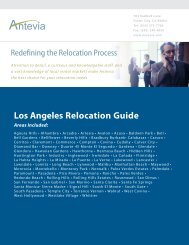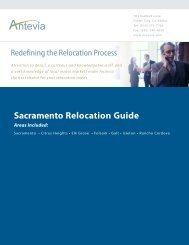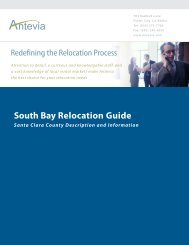San Francisco Relocation Guide - Antevia
San Francisco Relocation Guide - Antevia
San Francisco Relocation Guide - Antevia
Create successful ePaper yourself
Turn your PDF publications into a flip-book with our unique Google optimized e-Paper software.
The neighborhood was completely destroyed in the 1906 earthquake that leveled most of<br />
the city. During the city's rebuilding process, racist city planners and real-estate<br />
developers had hatched plans to move Chinatown to the Hunters Point neighborhood at<br />
the southern edge of the city, even further south in Daly City, or even back to China; and<br />
the neighborhood would then be absorbed into the financial district. Their plans failed as<br />
the Chinese, particularly with the efforts of Consolidated Chinese Box companies, the<br />
Chinese government, and American commercial interests reclaimed the neighborhood<br />
and convinced the city government to relent. Part of their efforts in doing so was to plan<br />
and rebuild the neighborhood as a western friendly tourist attraction. The rebuilt area that<br />
is seen today, resembles such plans.[1]<br />
Many early Chinese immigrants to <strong>San</strong> <strong>Francisco</strong> and beyond were processed at Angel<br />
Island, now a state park, in the <strong>San</strong> <strong>Francisco</strong> Bay. Unlike Ellis Island in the East where<br />
prospective European immigrants might be held for up to a week, Angel Island typically<br />
detained Chinese immigrants for months while they were interrogated closely to<br />
determine if they were really who their papers said they were. Several monuments and<br />
memorials have been erected to those who made it through the questioning and those who<br />
did not and were deported; and the entire detention facility has been renovated in 2005<br />
and 2006 under a special federal grant.<br />
The repeal of the Exclusion act and the other immigration restriction laws and the War<br />
Brides Act, which allowed Chinese-American veterans to bring their families outside of<br />
national quotas, led to a major population boom in the area during the 1950s. In the<br />
1960s, the shifting of underutilized national immigration quotas brought in another huge<br />
wave of immigrants mostly from Hong Kong, which changed <strong>San</strong> <strong>Francisco</strong> Chinatown<br />
from predominantly Taishan-speaking to Cantonese-speaking. The end of the Vietnam<br />
War brought a wave of Vietnamese refugees of Chinese descent, who put their own<br />
stamp on <strong>San</strong> <strong>Francisco</strong> Chinatown.<br />
There were many Chinese in Northern California living outside of <strong>San</strong> <strong>Francisco</strong><br />
Chinatown, but except for Oakland, they did not set up any special town with shopping<br />
and restaurants. With the growth of the Chinese-American population and the increasing<br />
difficulty of traveling into the congestion around downtown <strong>San</strong> <strong>Francisco</strong>, commercial<br />
developments began in the outer neighborhoods of the Richmond District and Sunset<br />
District and in other suburbs across the <strong>San</strong> <strong>Francisco</strong> Bay Area as well as newer<br />
immigrants – such as Mandarin-speaking immigrants from Taiwan who have tended to<br />
settled in suburban Milbrae, Cupertino, Milpitas, and Mountain View – avoiding <strong>San</strong><br />
<strong>Francisco</strong> as well as Oakland entirely. This suburbanization continues today.<br />
In the summer of 1977, an ongoing rivalry between two Chinese American gangs erupted<br />
in violence and bloodshed, culminating in a shooting spree at the Golden Dragon<br />
Restaurant on Washington Street. Five persons were killed and 11 were wounded, and the<br />
incident has become infamously known as the Golden Dragon massacre. The restaurant<br />
still stands today and remains a popular dim sum restaurant for tourists.







